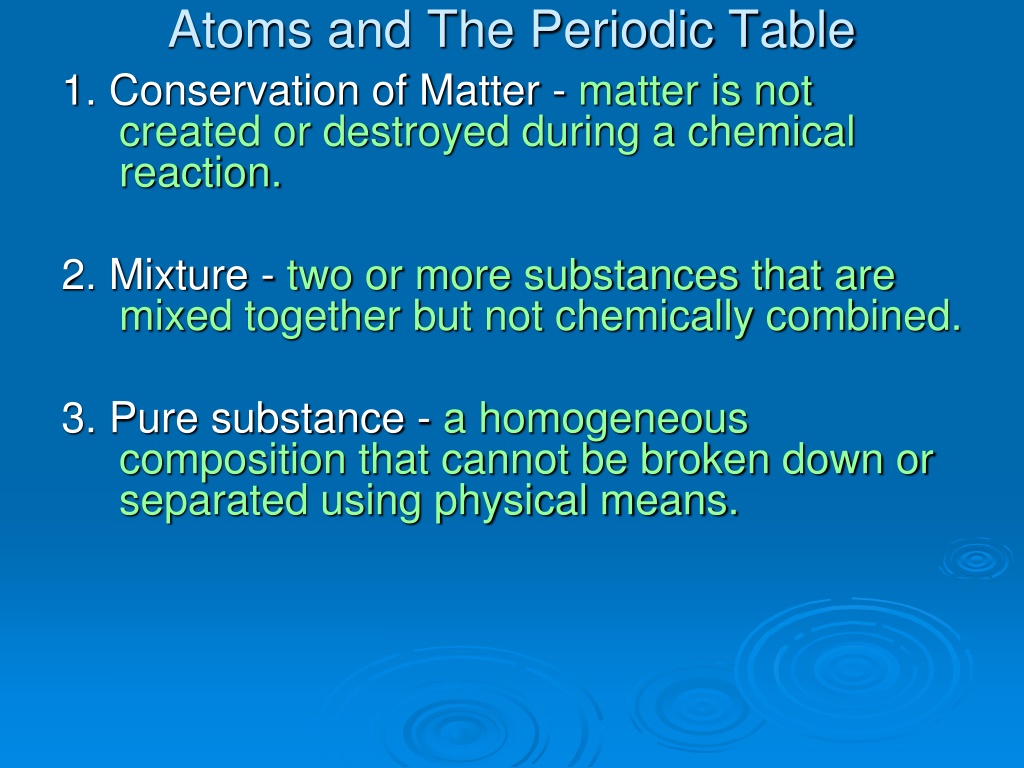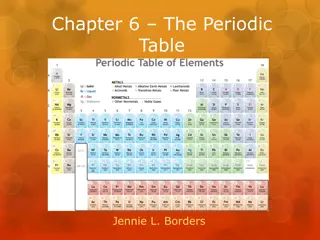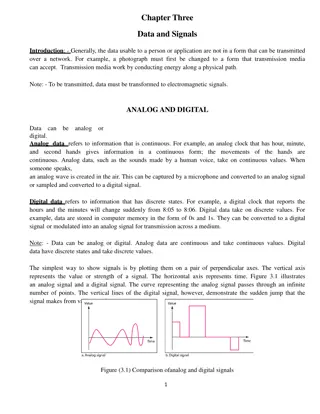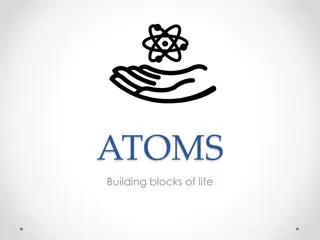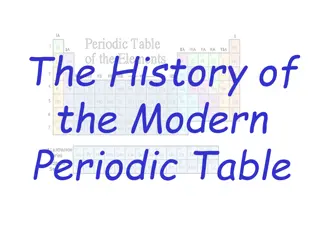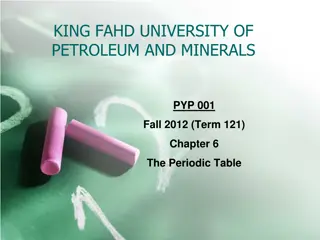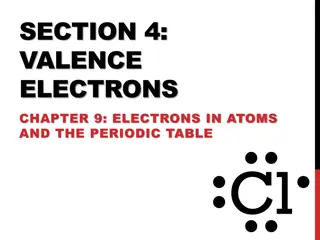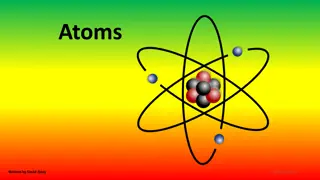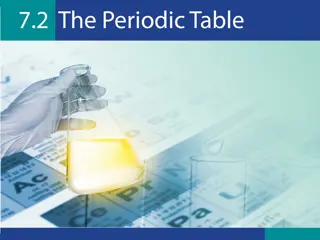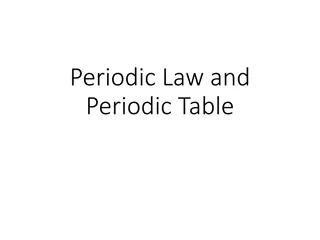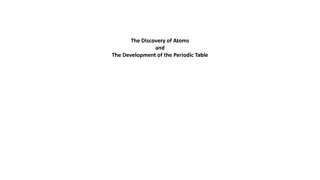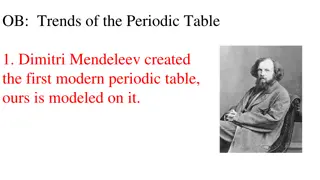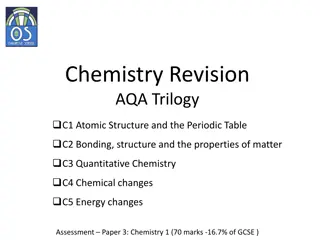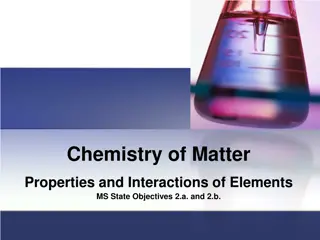Understanding Atoms and the Periodic Table
Explore the fundamentals of atoms and matter, including the conservation of matter, mixtures, pure substances, and the properties of metals, metalloids, and nonmetals. Discover the significance of valence electrons, the neutral state of atoms, and the classification of elements on the periodic table. Gain insights into the nature of heterogeneous and homogeneous mixtures, the characteristics of matter, and the composition of substances. Delve into essential concepts in chemistry to enhance your understanding of the building blocks of our universe.
Download Presentation

Please find below an Image/Link to download the presentation.
The content on the website is provided AS IS for your information and personal use only. It may not be sold, licensed, or shared on other websites without obtaining consent from the author. Download presentation by click this link. If you encounter any issues during the download, it is possible that the publisher has removed the file from their server.
E N D
Presentation Transcript
Atoms and The Periodic Table 1. Conservation of Matter - matter is not created or destroyed during a chemical reaction. 2. Mixture - two or more substances that are mixed together but not chemically combined. 3. Pure substance - a homogeneous composition that cannot be broken down or separated using physical means.
Atoms and The Periodic Table 4. Matter - anything that has mass and takes up space. 5. Metalloids - an element that has some characteristics of both metals and nonmetals. 6. Homogeneous Mixture Two or more substances not chemically combined. CANNOT see individual parts of the mixture. 7. Heterogeneous Mixture- Two or more substances not chemically combined. Individual parts of the mixture are visible. 8. Valence electrons - are the electrons in the outermost energy level of an atom, they determine how atoms will combine with other atoms.
Atoms and The Periodic Table 9. Approximately how many elements have we discovered or created in labs? 120 10. Give two examples of a Heterogeneous mixture. Vegetable soup and chocolate chip ice cream. 11. Name four things that are not matter. Thoughts, light, heat, and emotions. 12. All matter is made of atoms. 13. Where are the metals, metalloids, and nonmetals located on the periodic table? Metals are on the left, Metalloids are between the metals and nonmetals, and the nonmetals are on the right.
14. All substances are either atoms, elements, molecules, or compounds. 15. Is air matter? Explain your answer. Air is matter because it has mass and takes up space. 16. Explain why atoms in their natural state are neutral. Atoms in their natural state are neutral because they have the same number of protons (+) and electrons (-).
17. Does every atom of the same element have the same number of protons? Why or Why not? Yes, every atom of the same element has to have the same number of protons. The number of protons determines the type of atom. Example, all hydrogen atoms have 1 proton and all helium atoms have 2 protons. 18. Which element is the only metal that is not a solid at room temperature? Mercury 19. Compare and contrast properties of metals and non-metals. Metals Nonmetals Malleable Shiny Brittle instead of malleable Dull Solid at room temperature (except mercury) Good conductors of electricity Gas at room temperature (except bromine) Poor conductors of electricity
20. Find the names of each of the following elements on the periodic table and classify as either metal, nonmetal, or metalloid: Ca, Cl, I, Ir, Si, and Ti. Metals Nonmetals Cl-chlorine I-iodine Metalloids Si-silicon Ca-calcium Ir-iridium Ti-titanium 21. A mixture is created when two pure substances are combined so that each of the pure substances retains its own properties. 22. Where is the majority of the mass of an atom located? In the nucleus. 23. If an atom loses electron s, will it have a positive or negative charge? Explain. Positive charge, because atoms on the periodic table are neutral. That means they have an equal number of protons and electrons. If it loses one negative electron, then the charge of the atom will be positive 1.
24. What element has 31 electrons, 31 protons, and 39 neutrons? Gallium 25. Give the chemical formula for each of the following elements or compounds: a. Carbon C Water H2O Carbon monoxide CO Carbon dioxide CO2 Sodium Chloride NaCl Oxygen (molecule) O2 b. c. d. e. f. 26. Use the periodic table to complete the data chart below: Symbol Name Atomic Number Average Atomic Mass Si Ar Mg Ne 14 18 12 10 28.086 39.948 24.305 20.179 Silicon Argon Magnesium Neon
27. What element is in Group 1, Period 3? Sodium 28. What element is in Group 2, Period 3? Magnesium
29. Draw and label the atomic structure of Boron (label the protons, neutrons, and electrons). electron 30. Draw and label the atomic structure of Oxygen (label the protons, neutrons, and electrons). electron
31. List the characteristics of elements in each of the following groups and the groups location on the periodic table: Alkali Metals Group 1, most reactive metals, one valence electron, many are salt forming elements, soft, Alkaline Earth Metals Group 2, slightly reactive metals, two valence electrons, many are minerals Halogens Group 17, most reactive nonmetals, have 7 valence electrons many are used as disinfectants Noble Gases Group 18, least reactive elements, full outer electron cloud, many are used in neon signs. Boron Family Group 13, have 3 valence electrons Transition Metals Groups 3-12, hard metals with high melting points,
How many molecule, total atoms, and different types of elements? 1. C2H6 2. 2MgO 3. 4P4O10 4. NH3 5. 3 Al(OH)3 6. 2 H2O2
Law of Conservation of Matter Are these chemical equations balanced? 1. P + O2 P4O10 2. Mg + O2 MgO How are balanced chemical equations and the Law of Conservation of Matter Related?
